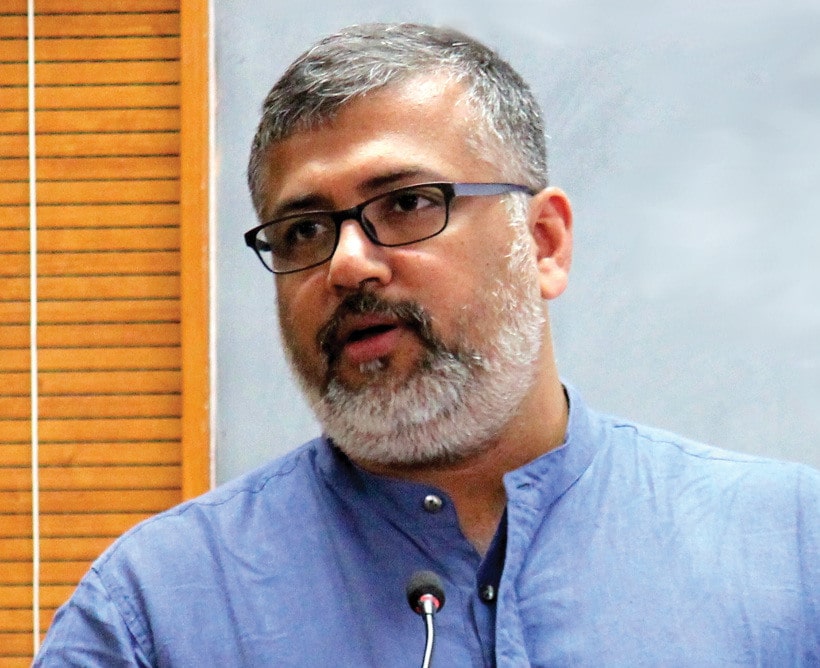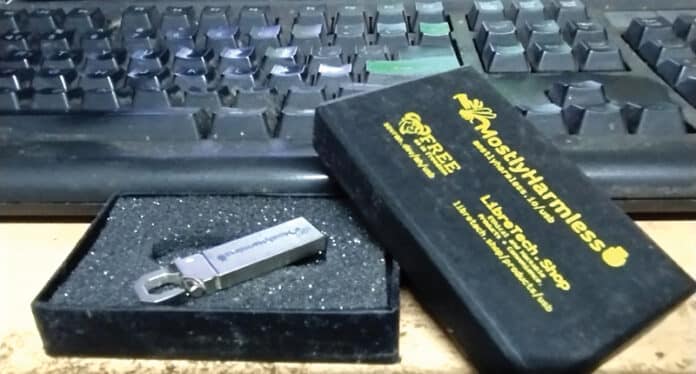Abhas Abhinav’s FOSS journey began in the late nineties. His love for open source has only grown stronger with the years, though he is not too happy about the way free and proprietary software are being mixed at will in today’s world.

Have you heard of the Mostly Harmless USB disk? What does it consist of? How does it work?
To learn more, meet Abhas Abhinav. He is a long-time community member of Free and Open Source Software (FOSS) networks in India, particularly (but not restricted to) Bengaluru. He tells the story of this disk: “It started as an experiment to offer a convenient and always accessible tool to showcase and use a free OS anywhere. I have made multiple variants of it over the past two years. One was for the LibrePlanet conference in Boston, where we gave it out to some of the participants gratis — or at a price of their choosing.”
There are ten OSs in the Mostly Harmless USB disk — Debian, Ubuntu, Fedora, and Alpine Linux are live and installable. Tails is a portable operating system that protects against surveillance and censorship. Tails bootable allows you to browse the internet over TOR. Short for The Onion Router, TOR is free and open source software for enabling anonymous communication. As Wikipedia explains, it directs internet traffic via a free, worldwide, volunteer overlay network that consists of more than seven thousand relays. The price of the disk is `650.
As a part of the DebConf’23 conference (held in Kochi in 2023) swag, a unit of the MH-USB was given out to all the participants. This meant a total of around 300 units, in all, got distributed. This USB contained multiple images of various Debian GNU/Linux operating systems and derivatives.
Abhas recalls: “If you remember, there was a time when [Indian computer magazines] PC Quest, Linux For You (now known as Open Source For You), DeveloperIQ, and CHIP distributed a GNU/Linux CD. This helped precipitate GNU/Linux adoption in the late 1990s. Then, in the early 2000s, Ubuntu would send you a nice colourful CD if you just filled out a form on their website [and requested it].”
Abhas says his own endeavour is to try and replicate these instances in a different way. He hopes that having a bootable multi-OS USB handy on their key rings all the time “might enable people to do something that they found challenging in the past.”
But, he admits, it’s not a financially viable product. Abhas actually gives out more units than he sells. “But that’s fine with me since I look at it as a way to increase access to a bootable GNU/Linux OS.”
Many people appreciate it, and he finds that as “nice feedback.” Even a lack of feedback “does not really affect my motivation to continue spending money on fabricating and distributing MH-USB units. I think I will keep building and updating it as long as I can.”
The MH-USB partition of the USB drive is formatted with exFAT, allowing universal access to the data on any operating system that supports exFAT.
Today, he feels, the dominant way of using software is to just use a browser. “Then, the software is not on your computer or a computer that you control,” he adds.
Liberated hardware products
So what are his new initiatives? “Several,” he says.
‘Liberated hardware’ is hardware that can run free software but isn’t necessarily designed to do so. At the LibreTech.Shop, over the past year, Abhas has listed quite a few ‘liberated hardware’ products that offer free software on a device by default. These include:
- Mobile phones running LineageOS, the open source Android distribution available for several devices (or Ubuntu Touch, designed primarily for mobile devices, or PostmarketOS, tiny and under 10MB in size).
- Wireless routers running OpenWRT, meant for embedded devices.
- ‘Smartwatches’ that run a free OS called AsteroidOS, the FOSS operating system for smart watches.
- Liberated computers (laptops and desktops) that offer a perfect GNU/Linux experience out-of-the-box and are powered by Coreboot (the free software BIOS replacement). Coreboot describes itself as “an extended firmware platform that delivers a lightning fast and secure boot experience on modern computers and embedded systems. As an open source project it provides auditability and maximum control over technology.”
- Home automation solutions, including wireless switches and Wi-Fi tubelights to start with. Wireless switches enable you to switch on/off a mains outlet over the network. A Wi-Fi tubelight lets you switch the tubelight over the network as well as change its colour and brightness, all with 100% free software and without requiring internet access or a proprietary mobile app.
Abhas says: “What I am attempting to do is remove the last bit of hesitation that someone might have with using free software in more places. If I can sell the same products that people might purchase off-the-shelf with free software pre-loaded, that might be the convenience they’re searching for. The ‘sales’ are not really encouraging right now, but I am hoping that setting up a stall at various community events might help change that.”
“I’m trying to tell somebody about the beauty of GNU/Linux, and I don’t have a USB disk at hand to show it to them live on their computer. Or to even install a thing that they can test and see first-hand. We also need to fix computers sometimes, or to install something. We need to have something all the time,” he explains.
Since he got started in the late 1990s, how has his work changed, and how has the discourse changed?
“My vision was to run a business where I could charge people for running free software for them. It remains the same even today. Ironically, it’s getting more difficult to do that sometimes, as compared to the early 2000s. At that time, people were used to the idea of installing software on their own computers,” Abhas adds.
Tech… and politics
Does he agree with the view that the Indian techie often doesn’t understand — or care for — the politics involved in technology? Says Abhas: “It depends on who you talk to and which circles you’re in. But a lot of people do not. That is true.”
Thankfully, as he puts it, journalists and activists are more aware of this aspect today. “They understand the dangers of proprietary tracking systems.”
He argues: “The respect for the freedom we have only grows when we lose some of it or all of it. But many have not thought about losing freedom.”
Server space
Two decades back, when we first met, Abhas was very much into the server space. Does his passion for the server continue?
“Yes. I still work with servers. It’s important to do self-hosting at the individual or family level,” he says.
Many people want to use free software. One option is to host it yourself. You need a small server that you would pay for. When you install your own software, you run your email, activity-powered social presence, microblogging, and videos. Use it to sync pics from your phone, or run a chat server. All of that is possible, he points out.
But it doesn’t come easy. The problems one encounters can be twofold — most people don’t know how to get started. They often think there are many challenges to get a server up and running.
“But by opting out of that decision making, they are also opting for proprietary software. We are trying to show them various ways to do it differently. Do it on Raspberry Pi, a cheap server, or even on a wireless router. We show the examples, and people can choose the place where they want to host it,” he explains.
“If others control all this software, then they control the software which runs on it, and the data which resides on it. They control the way it goes out to others, and to whom. That is not what the internet was meant to be. It was a place where we all run our own space, and run it in a truly federated manner,” he notes.
Some of the sites worth visiting, related to Abhas’ work:
|
The FOSS journey
As a student, in 1997-98, Abhas recalls constantly seeking new things to do with his computer. This led to experimentation with other operating systems (OSs) such as OS2 and Windows NT. During this time, he bought a book to learn about Linux, which everyone was talking about. He taught himself a “little bit of LaTeX” too. “Then, there was no looking back,” he remembers.
FOSS, he believes, is a serious option for youngsters to generate employment and acquire valuable skills. He points to the bigger picture: “When you feel that pressure is building up in the place you’re in right now, you will make a different choice. Free software is one of the best ways to do that. Using free software can often be the best way to solve a problem.”
Biggest challenges
What does Abhas see as the biggest challenges before FOSS (Free and Open Source Software) or FLOSS (Libre, too) software in India today?
He says, “I feel that, in general, GNU/Linux usage is decreasing, and that is a concerning trend. For a lot of younger people, it is entirely normal to run free software on proprietary operating systems or alongside a mix of proprietary software.”
Apart from desktop operating systems, there are other systems involved too that are proprietary. A lot of free software is developed around GitHub, a proprietary version control system and community operated by Microsoft. There are many more such online proprietary ecosystems. “For some reason, we no longer feel uncomfortable about mixing proprietary and free software in this way,” he argues.
If you ask a group of students how they would build an online group for collaboration, the most popular responses are: WhatsApp, Telegram, Discord, etc — all proprietary systems. “The first tools of choice are not email, mailing lists, matrix or something else that is free software and can be self-hosted and maintained by ourselves. This blurring of the line between free and proprietary software is what is worrisome,” he adds.
Several things have disappeared from the common ‘FLOSS discourse’ in India. No one really talks about localisation (Indic language solutions in FOSS) anymore. Or the freedom to compute freely and privately. Or even having fun, Abhas says, with a tinge of regret. As he puts it: “Lest we forget, Torvalds wrote the Linux kernel ‘just for fun’ (as goes the title of his autobiography). He wanted to understand how the 80386 CPU from Intel worked, and he decided to write an operating system kernel for that. The rest is history… but it all started with the need to have a certain sort of fun. And I feel that this too is missing.”












































































